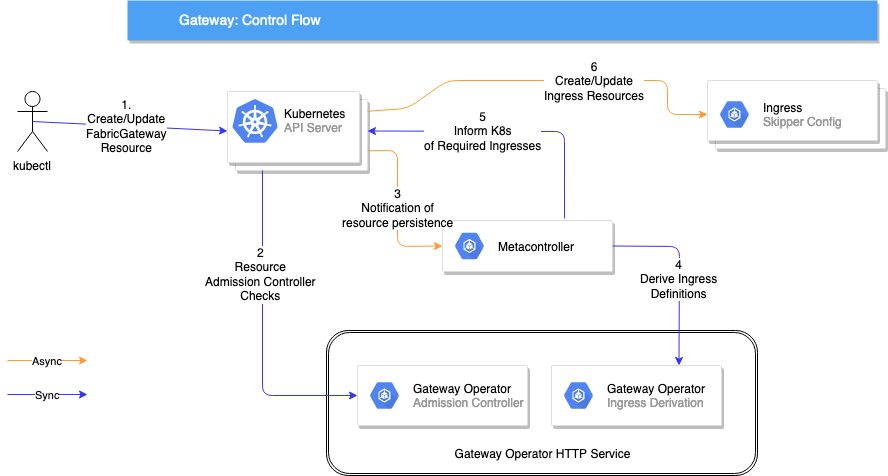Fabric Gateway is an API Gateway built on Skipper. Skipper is a HTTP router which has many features which are applied on a route-by-route basis, where each route is configured by a single Ingress. Fabric Gateway generates these ingresses to support authentication, rate-limiting and more from a single OpenAPI-style Custom Resource Definition.
The following features are supported:
- Authentication
- Authorization
- Service Whitelisting
- Rate Limiting
- Plaintext Request Rejection
- Cross-Origin Resource Sharing
See the Getting Started guide.
The docs folder contains the documentation site, and is built using mkdocs. To update the docs folder, make your modifications in the docs-raw folder and run:
./make-site.shMake sure that you have the correct version of mkdocs material installed to avoid large deltas:
pip install mkdocs-material==5.5.0Currently this gateway operator integrates with Skipper as an ingress provider. The Gateway operator gives you the ability to consistently configure a suite of functionality applied to a list of routes without having to tie yourself to any specific ingress implementation. An overview of how this operator works once deployed can be seen below:

The HTTP endpoints exposed by the operator are as follows:
- /health: This is to be used with Kubernetes health probes
- /synch: supports POST requests in the metacontroller format to derive a list of ingress resources to match the desired feature set outlined in the
- /validate: supports POST requests in the Kubernetes admission controller format and applies extra validation rules that are not possible via schema validation alone.
We use scalafmt to format code. Follow the instructions to set it up with intellij.
The project is using SBT as it's build tool. To build and run the unit and integration tests, execute the below command in the root of the project:
sbt clean testIf you want to run the application locally, you can run from within your IDE by starting the App which will bind locally to port 8080.
Alternatively you can create a runnable jar by invoking the below sbt command:
sbt clean test assemblyand then running the generated jar by executing the below:
java -jar target/scala-2.12/fabric*.jarOr simply by invoking
sbt runWe use feature flags to optionally enable/disable functionality for the Gateway Operator. Feature flags are activated via environment variables. The currently supported feature flags are outlined below:
-
WEBHOOK_TLS_ENABLED: If using the admission controller, it's a requirement that the webhook address is reachable via HTTPS. Setting this flag to
TRUEwill cause the service to accept HTTPS traffic on port8443. -
WEBHOOK_TLS_UNSAFE_KEYSTORE_ENABLED: To make it easier to Test/Dev this service, there is a bundled keystore which has a certificate created by a dummy CA. Setting this flag to
TRUEin conjunction with the above feature flag, will use the bundled unsafe certificates to validate incoming HTTPS requests. The caBundle which is included in the Admission Controller resource is valid to use with the bundled keystore. -
WEBHOOK_TLS_JKS_FILE_LOCATION: If you are enabling TLS as per the above mentioned feature flag and do not wish to use the unsafe bundled keystore, you can provide a location to load your own keystore from using this env var. This location should be a file path available at startup for the service.
-
WEBHOOK_TLS_JKS_PASSWORD: If you are using your own Keystore as per the above env var, then you need to provide a Base64 encoded password to access the keystore via this env var.
-
VERSIONED_HOSTS_ENABLED: When this is true, our stackset feature will generate a version-specific host with all auth rules intact for accessing a specific version of a service.
-
VERSIONED_HOSTS_BASE_DOMAIN: This must be set when
VERSIONED_HOSTS_ENABLEDis set. This will be used as the base domain for the versioned hosts. For example if this ismy-domain.comand a stackset has servicemy-service, then the version-specific host ismy-service.my-domain.com.
When a fabric gateway is created you can view it using kubectl:
kubectl get FabricGatewaysYou can get a detailed description of the existing gateway with the below command:
kubectl describe FabricGateway my-gatewayTo generate a report of all licences used in this project execute the below. This report should be generated any time an update is made to the project dependencies and the updated report should be stored in the project root.
sbt clean dumpLicenseReport && mv target/license-reports/GatewayOperatorDepLicenses.md .The current checked in report is available to view here